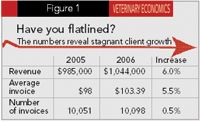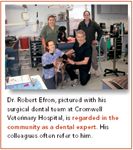Pump it up
You've admired those beefcake practices from afar. You envy their solid client growth and muscular marketing techniques. Well, here's how to supercharge your practice's growth.
IS YOUR PRACTICE WIMPY? FLAT ABS MAY BE YOUR GOAL when you're doing crunches, but flat isn't so ideal when it comes to your practice's growth. So if you've plateaued, it's time to whip those financials into shape.

Gary I. Glassman, CPA
The first step: Find the reasons for the stalled growth. Often it's largely due to a market saturation of veterinary practices and a lack of marketing innovation.
Step two: Fix the problem.

Know your numbers
Remember, the number of invoices you produce and the size of the average transaction are what drive practice income. So you can run a diagnostic by using your veterinary software to track the number of invoices and the average invoice total on a year-to-year basis.
It's important to look at both of these numbers; a practice that's seeing sales growth could still be stalling because it's not attracting new clients or hanging on to the ones it has. For example, review the numbers for Loving Pet Animal Hospital, a small-animal hospital in Durham, N.C., in Figure 1. In one year, the practice gained 325 new clients. This should mean that the practice generated at least this many more invoices, if not even more than that. But that's not the case. The invoice base grew only by 47 invoices for the entire year, suggesting that the practice had high client attrition, losing more total clients than it added. These numbers tell us that most if not all of the practice growth came from an increase in the average invoice and not from an increase in the volume of invoices.

Figure 1.
Do you have time to do more?
Growth in the number of invoices or client visits is what builds long-term value for a practice. Short-term increases in the average invoice generally don't build value but rather cover inflation-indexed expenses. Usually this jump comes from a fee increase. However, a practice that's adding services may see more significant growth in the average invoice. So if your average invoice jumped 5.5 percent, you've adjusted for inflation in your costs. If you saw a 10 percent increase, you probably added new services.
To better understand hospital invoices, compare your practice to the industry benchmarks in companion-animal hospitals. Loving Pet Animal Hospital employs two full-time equivalent (FTE) doctors. A general rule of thumb is 5,000 hospital invoices per FTE veterinarian. Since the practice generates 10,098 invoices, it's likely near its capacity.

If you're in the same position, further growth might be possible with high-density scheduling and by leveraging your staff more—if these strategies are a good fit for your practice. A look at Loving Pet's appointment book indicates that the schedule is filled about 85 percent of the time, and appointments at the most convenient times—evenings and Saturdays—are always booked one to two weeks out. Emergency slots are filled by 9 a.m., and routine surgeries are booked a week and a half out.
The average active client base per FTE doctor is 1,200 to 1,400 clients. This practice, with two FTE doctors, is on the high end of the scale. And the industry average for new clients is 25 to 30 new clients per month per FTE doctor—this practice is below average. The practice is seeing 25 new clients per month even though it's a two-doctor FTE practice that should be seeing 50 to 60 new clients per month.

Often a hospital experiences a low new-client number because the available appointment slots are inconvenient for clients. In this case, you need additional doctor hours to overcome the stalled growth. Of course, it doesn't make sense to begin marketing the practice to new clients and offer additional services if you don't have enough doctors to handle the new business.
6 ways to generate more growth
If you have the capacity to handle additional invoices and increase practice activities, these ideas could help your team kick-start growth.
- Improve visibility and community awareness. Practice visibility centers on signage and clients' ability to see the facility. Is the sign visible from the street? How large is it? Is it adequately lit at night? Accent lighting on the exterior of the building also can make a world of difference to the practice's curb appeal. If your building is blocked by obstructions such as fences and trees, clear them. You want to make sure the practice looks great from all directions.
- Develop a Web presence. I don't think you can practice today without a Web site. It's your electronic brochure, and with this tool you can give clients access to your hospital 24 hours a day for information and to book appointments, refill prescriptions, and complete hospital forms.

You may need to spend a little more, but ask your Web site developer to optimize your site for search engines so it pops up easily when clients are looking for you. And try searching for your own site periodically to make sure it's working the way you expect.
Keep in mind that some clients would rather connect to the Internet than open a phone book. They search the Web or use online directories when they need services. So consider reducing Yellow Pages ads in favor of a stronger Internet presence. Ideally, you'll link your online Yellow Pages listing to your Web site. Be sure to review all of the companies that offer directory listings to find the best value, and consider buying a sponsor listing that will improve your Web presence.

- Leverage your team. If the focal point of your marketing strategy is to improve the average invoice, consider additional passive services that don't require a significant amount of your time. Involve your staff and get them to participate in the marketing efforts.

"It's all about the staff at our practice," says Florence Sanford, practice manager at Nassau Veterinary Clinic in Nassau, N.Y. "Our team members are very active in planning our community outreach events. It keeps them interested and gives them something fun to do outside of their regular job duties."
And your team members could be the most effective means to promote activities such as puppy and kitten socialization classes or behavior classes. It could be as easy as having team members wear buttons that say, "Ask us about our behavior classes."
- Get your name out there. Beefing up your presence in the community helps get the hospital's name out. Offer open houses, hospital tours, and lectures to various groups to give potential clients a chance to get to know you. And be sure to send participants home with some information about the hospital.
Dr. Larry Linnetz of Chippens Hill Veterinary Hospital in Bristol, Conn., works with local children's groups in his community. He attends these events accompanied by exotic birds or snakes that the kids can interact with and he teaches them about different species of animals. Dr. Linnetz says this type of event educates people about the practice and is great community outreach. "People tend to say, 'Oh, I didn't know you treated birds,'" he says. "If they have a friend with a bird, or they end up with one someday, they think of us."
His practice also exhibited at the Hartford County Fair Home Show and brought birds and snakes to the three-day event. "Our regular clients appreciated seeing us there. It helped them realize that we care about the community," Dr. Linnetz says.
Practice manager Kim Hotchkiss says that reaching out and educating people is what Chippens Hill thrives on. "There's nothing better than getting out in the community and showing people what we do," she says.
Nassau Veterinary Clinic also stays actively involved in its local community. For example, the clinic donated doggy waste stations to a local park. The stations, complete with baggies and waste bins, encourage park visitors to clean up after their dogs—and they prominently feature the practice's name. "Seeing our logo and name in so many places throughout our community leaves an imprint," says Sanford. "People will remember us when their pets need veterinary care."
The clinic also sponsors a local Little League baseball team. For its sponsorship the practice name is displayed at the park and on the team's T-shirts.
- Don't forget about current clients. Natalie Smith, practice manager at Cats Limited Veterinary Hospital in West Hartford, Conn., says promoting services to existing clients has helped pump up growth in her practice. "It's the most inexpensive marketing you'll ever do," she says. "And it's very effective."
Her team uses a bulletin board in the waiting area to educate clients about services they offer. For example, the practice is moving to a new facility in the spring, so they've used the bulletin board to announce that the boarding facilities will be expanding. "We're trying to get a jump on what's coming up for us," she says. "And the notices we put up generate a lot of interest among our clients."
The information on the bulletin board changes seasonally. One spring, the practice used the bulletin board to promote grooming services. "Quite a few clients didn't even realize we offered grooming services," Smith says. "We got a lot of business from that."
- Do what you want to do. Find a specialty or niche that interests you and consider adding it to your list of services. For Dr. Robert Efron of Cromwell Veterinary Hospital in Cromwell, Conn., that specialty was dentistry. When he started exploring that interest, he promoted dental care more heavily and raised his average professional invoice to $160.
Today Dr. Efron is known in the community as a veterinarian with a strong interest in dentistry, and he gets about 10 percent of his cases from referrals. "It's an ego builder when a colleague trusts you enough to send clients to you for a root canal," he says.
Dr. Efron's love of dentistry reaches beyond animal health. He gives talks to local human dental hygienist groups and makes an effort to interact with human dentists on a regular basis. "I pick their brains whenever I can," Dr. Efron says.
If you're experiencing flat growth, you're not the first and you won't be the last. And there are fixes. Just identify the source of the issue and make a change—but don't do it alone. Enlist the help of your entire team. After all, your team members have a stake in your practice's growth, too.
Veterinary Economics Editorial Advisory Board member Gary I. Glassman, CPA, is a partner at Burzenski and Co. PC in East Haven, Conn. Send questions or comments to ve@advanstar.com.